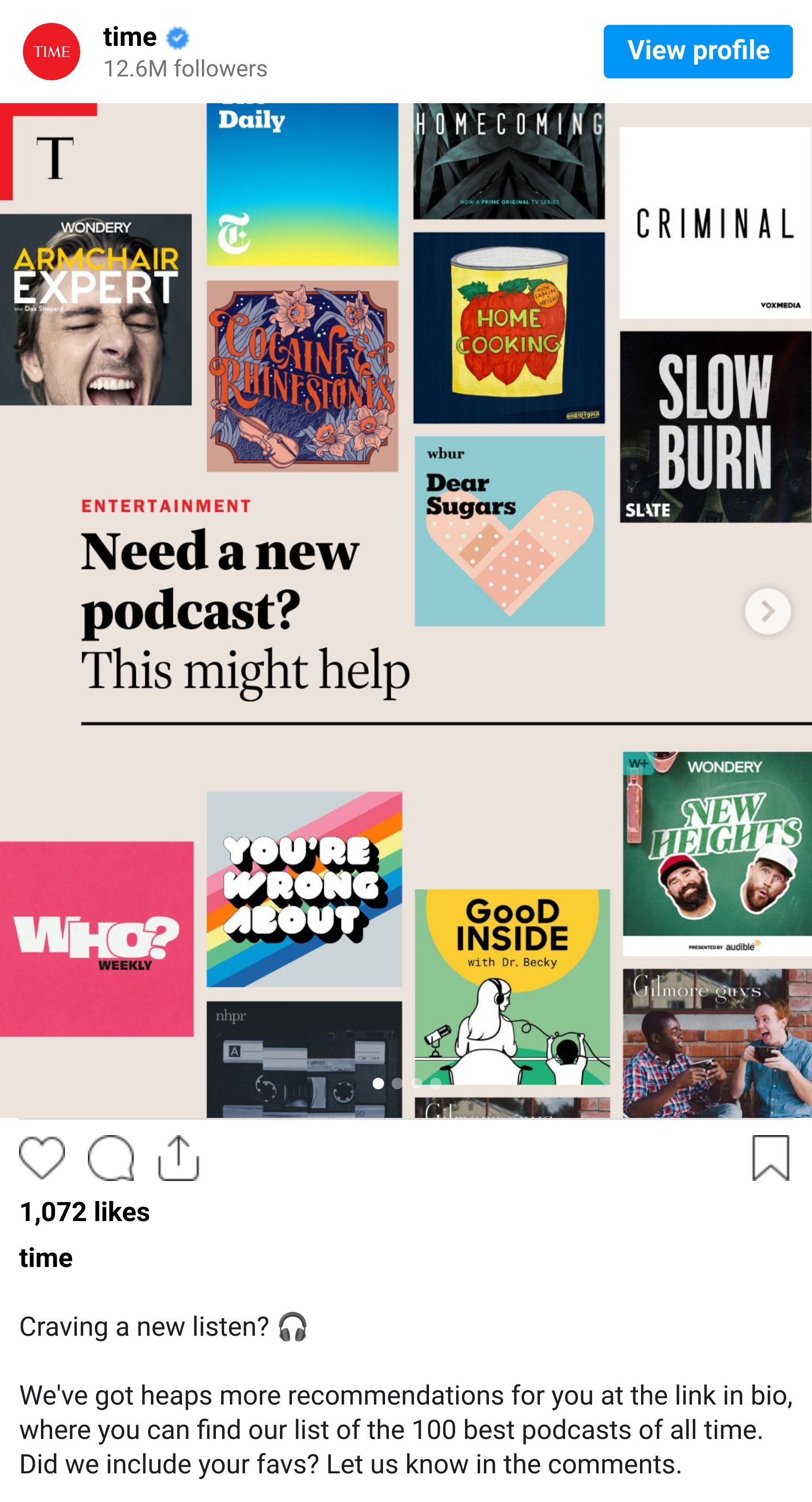Welcome
Take the space
This week’s buzzy TikTok trend—”read the text and move on with your day”—has people sharing a cringe-worthy text from dad/boss/bf, paired with videos of them unfussed and carrying on. Cringe humor aside, it’s actually not bad advice as we head into the holiday season, with it’s tendency for overstimulation and awkward family moments. Pause, take a breath, and circle back…or don’t.
Speaking of pauses — no newsletter next week, as Thursday is Thanksgiving. Whether you celebrate, avoid, protest, or begrudgingly join your family for a 7am turkey trot, I wish you a wonderful week and I’m always grateful you’re here.
Best,
Enid
📬 [email protected]
This week 🗓️
🎧 Apple’s Top Podcasts Tout Celebrity and True Crime
🧩 What’s happening
Want an idea of what’s in people’s heads? Look at their podcast queue. Apple Podcasts just dropped its roundup of the most popular podcasts of 2025 and gave us a glimpse into the psyche of listeners. The Daily and The Joe Rogan Experience continue to dominate overall charts, while shows like Good Hang with Amy Poehler, The Mel Robbins Podcast, and SmartLess fight for spots alongside true crime pods. And the top episode of the year? The Telepathy Tapes: “Unveiling the Hidden World of Telepathic Communication in a Silenced Community.”
💬 Why it matters for therapists
The charts show our penchant for polarization (Joe versus the NYT) and trauma as entertainment. But pods also increasingly feed the parasocial relationships that are becoming commonplace. The bro pod feels like hanging out with the guys; celebrity interviews feel intimate and personal. And there’s a podcast for just about everything—for better or worse.
🪞 How it may show up in the room
Clients leaning on podcasts for mentorship, guidance, and companionship.
Pressure to self-optimize after listening to wellness or productivity pods.
Excitement (potentially short-lived) for novel ideas pushed via podcast.
🛋️ What therapists can do
Explore how and why certain topics resonate with clients.
Help clients differentiate parasocial closeness from real relational reciprocity.
Encourage reflection on how media shapes mood, self-talk, and expectations.
🔗 Go deeper
“Apple Podcasts unveils the most popular shows and trends of 2025” — Apple, Nov 2025
“The one-sided intimacy of being a fan” — Vox, Aug 2025
“Feel a connection to a celebrity you don’t know?” — The Guardian, Nov 2025
💡 The bottom line
Podcasts aren’t alt—they’re shaping identity, mood, and meaning. For many clients, they may feel closer than friends.
🪷 King of the Hill, Wabi-Sabi, and a Collective Exhale
@indi_the_puppy i love my bulldog, but why’s she sitting like that….#dogsoftiktok #bulldog #puppy #fyp #wabisabi
🧩 What’s happening
A clip from King of the Hill—“I like how mine’s a little off center. It’s got wabi-sabi”—has gone viral on US TikTok, sparking a trend where creators celebrate the imperfect, the crooked, the slightly-off. Think: self-cut bangs, snaggle teeth, and uneven eyebrows. The meme has become a kind of digital palate cleanser, countering the hyper-polished and unrealistically aspirational posts that dominated the last decade.
💬 Why it matters for therapists
This riff on the Japanese aesthetic philosophy of wabi sabi reflects real exhaustion with perfectionism and self-optimization—the exact pressures many clients carry into the room. There’s relief in enjoying the messy middle.
🪞 How it may show up in the room
Difficulty disconnecting from feelings of failure for not keeping up with “perfect” online personas.
Relief when seeing others embracing imperfection.
Permission to soften self-criticism, even briefly.
🛋️ What therapists can do
Diffuse shame around desiring what we see online—whether perfect or wabi sabi—it’s normal to want to be part of the “in group.”
Discuss clients’ relationships to imperfection and control.
Explore reactions to “good enough.”
🔗 Go deeper
“The ‘Wabi-Sabi’ TikTok Trend Is Actually Adorable, TBH” — Her Campus, Nov 2025
“King of the Hill's Bobby Hill becomes TikTok's symbol of imperfect beauty” — Mashable, Nov 2025
💡 The bottom line
Social media has driven aesthetic perfection and unrealistic expectations for years. The internet is tired—and wabi-sabi is an exhale.
🎈The Thanksgiving Day Parade
🧩 What’s happening
The Macy’s Thanksgiving Day Parade lineup dropped, and it’s a snapshot of where American culture sits right now: somewhere between deep nostalgia and the thrill, and discomfort, of the new. Classic floats are returning, but this year’s buzziest additions include the K-Pop Demon Hunters and Labubu balloons. For the traditionalists who lament Labubu, it’s good to remember that what’s nostalgic now was once novel and even uncomfortable. The iconic parade was started by first-generation immigrants and the beloved balloons were once decried as commercial eyesores.
💬 Why it matters for therapists
Traditions like the parade—a ritual of American nostalgia—can be divisive both inter- and intra-personally, as we grapple with both the comfort and pain of our past.
🪞 How it may show up in the room
Nostalgia as a coping skill or defense mechanism.
Family conflicts over tradition vs. novelty.
Grief if certain rituals no longer feel grounding.
🛋️ What therapists can do
Explore clients’ nostalgia, and if it manifests as comfort, coping, or concern.
Normalize ambivalence around changing traditions.
Help clients co-create new rituals that honor both past and present.
🔗 Go deeper
“'K-Pop Demon Hunters' and 'labubus' to join Macy's Thanksgiving Day Parade” — The Economic Times, Nov 2025
“How the Macy’s Thanksgiving Day Parade Went From Its Modest Start to an American Tradition Rivaling Stuffing and Pumpkin Pie” — Smithsonian Magazine, Nov 2024
“How the largely immigrant-founded Macy’s Thanksgiving parade became a national symbol” — The Guardian, Nov 2024
On nostalgia: “That yearning feeling: why we need nostalgia” — The Guardian, April 2024
💡 The bottom line
Yesterday’s chaos is often tomorrow’s comfort. Nostalgia is a moving target—and that’s okay.

